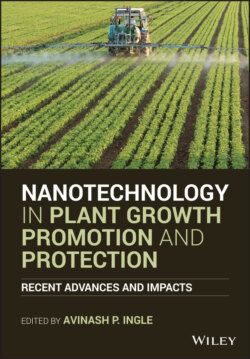Читать книгу Nanotechnology in Plant Growth Promotion and Protection - Группа авторов - Страница 19
1.2.3 Macronutrient Nanofertilizers
ОглавлениеMacronutrient nanofertilizers are fertilizers which provide the nutrients that the plant needs in large amounts such as nitrogen (N), phosphorus (P), potassium (K), calcium (Ca), magnesium (Mg), and sulfur (S) (Ditta and Arshad 2016; Zulfiqar et al. 2019). It is proposed that the need to apply macronutrient fertilizers will increase by the year 2050, and it may reach to 265 million tons (Chhipa 2017; Adisa et al. 2019). The high ability of penetration and the high surface area of nanoparticles make them more efficient to release the nutrients in controlled manner compared to traditional fertilizers. Considering these facts, nanofertilizers with potential of slow or controlled release of nutrients being developed from macronutrients. For example, nitrogen slow release nanofertilizer was developed from urea‐modified hydroxyapatite by Kottegoda et al. (2017) and evaluated their efficacy. The results obtained showed that initially nitrogen release from the developed nanofertilizer (urea‐hydroxyapatite nanocomposite) is rapid; however, later its slow release was continued till the 60th day from its application. This application of nitrogen nanofertilizer reported to increase rice yield even at 50% lower concentrations than traditional urea fertilizer (Kottegoda et al. 2017).
Liu and Lal (2015) synthesized a phosphorus (P) nanofertilizer of 16 nm particles using carboxymethyl cellulose‐stabilized hydroxyapatite nanoparticles and studied its effect on soybean growth. They applied the developed P nanofertilizer in soil in a greenhouse experiment and found that growth was increased by 33% and yield by 18% as compared with soybean treated with traditional P fertilizer. Mechanically, the hydroxyapatite nanoparticles have low interaction with soil particles than ionic P thus making uptake of P nanofertilizer easier than traditional P fertilizer. However, further studies are required to test the availability of P nanofertilizer under different soil types, pH, ionic states, organic carbon, and water content (Raliya et al. 2018). In another study, a biosafeP nanofertilizer was developed as a nano water phosphorite suspension (particle size: 60–120 nm) and tested on corn in greenhouse, field, and farm level. The results obtained showed that fresh yield, fruit yield, and production quality of corn plants increased several folds with the use of this P nanofertilizer as compared to traditional P fertilizer (Sharonova et al. 2015).
Hasaneen et al. (2016) and Abdel‐Aziz et al. (2019) used two types of NPK nanofertilizers: nanochitosan loaded with NPK and carbon nanotubes (CNTs) loaded with NPK for fertilization of French bean plants in greenhouse conditions. They used three different methods of application of nanofertilizers, i.e. seed priming, soil incorporation, and foliar application. The results obtained revealed that, foliar application was the best method of application for both the nanofertilizers. For foliar application treatment, the life cycle of the plant was shortened by 37.5% (80 days) as compared with other nano treatments or nontreated plants (110 days). Also, nanochitosan‐NPK showed better improvement in the crop plants than CNTs‐NPK (Hasaneen et al. 2016; Abdel‐Aziz et al. 2019). Abdel‐Aziz et al. (2016) reported that foliar application of nanochitosan loaded with NPK (10–100%) to wheat plants grown in sandy soil in greenhouse conditions improved the crop productivity and shortened the lifecycle of the plant by 40 days as compared with traditional NPK fertilizers. The lowest concentration of NPK nanofertilizer (10%) recorded to have best effects on wheat growth and productivity. This study lacks comparison of the results of nanochitosan‐NPK with pure nanochitosan. The nanochitosan used in these studies was produced by polymerization of methacrylic acid with chitosan.
Similarly, Ha et al. (2019) produced nanochitosan from ionic gelation of chitosan with tripolyphosphate and then loaded NPK on nanochitosan particles. They applied the nanochitosan‐NPK fertilizer to the leaves of coffee plants in greenhouse conditions. It was observed that application of this developed nanofertilizer enhanced the rate of photosynthesis, increased the rate of uptake of nutrients and growth of coffee plants as compared with untreated plants. The results obtained from the above‐mentioned studies were reported in greenhouse conditions, and field trials are important to validate the approach of using NPK nanofertilizers.
In groundnut, foliar application of nanocalcium oxide (CaO) fertilizer reported to increase Ca accumulation and root development in plants as compared with normal CaO and calcium nitrate (CaNO3) (Deepa et al. 2015). This study showed that CaO nanoparticles were transported through phloem, but the mechanism of its action is still not known. In another study, Mg nanoparticles (500 mg/L) in combination with normal Fe (500 mg/L) were used to treat black‐eyed pea (Vigna unguiculate) and showed an increase in seed mass (10%) as compared with plants treated with normal Fe (Delfani et al. 2014). Nano‐S was also shown to enhance root and shoot growth of tomato and pumpkin plants as compared with untreated plants (Salem et al. 2016a,b). Both these studies showed that the effect of nano‐S was concentration‐dependent and higher concentrations caused deleterious effects on the growth of both plants. This suggested that further studies are needed to adjust the suitable concentrations of applied nano‐S.
